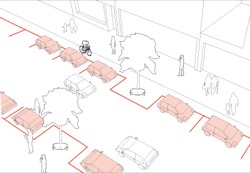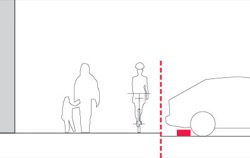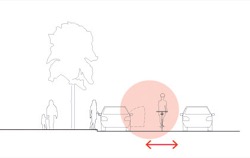On this page:
About on–street parking
On–street car parking is part of the movement network. It provides convenient, short–term parking in close proximity to activities and destinations.
On–street parking may be parallel, indented, angled, at kerbside or in centre–road islands. The street type and use pattern determines the appropriate type of on–street parking used.
Why is it important?
It plays an important role in inner urban areas with limited off–street parking. The presence of on–street parking can affect driver behaviour by reducing vehicle speeds.
Parking manoeuvres can interrupt and calm traffic flow, providing additional opportunities for pedestrians to cross a road. The presence of parked cars can make a street feel more inhabited.
Well managed on–street parking can provide a good service with a minimal number of car parking spaces.
2.7.1: ensure efficient provision of on–street parking
The civil design of on–street parking is guided by AS 2890.5:2020, Parking facilities Part 5: On–street parking.
- Provide a street cross–section that accommodates the appropriate type of on–street parking.
Tip: different types of on–street parking are appropriate for different street types: angle or centre road parking requires wider streets; parallel parking is more appropriate in narrow streets.
2.7.2: ensure on–street parking contributes to pedestrian amenity and safety
- Arrange kerbside and indented parking on streets as part of the buffer zone between pedestrians and moving traffic.

Tip: if no on–street parking is provided, ensure traffic speeds are managed to achieve a sense of safety for pedestrians.
2.7.3: optimise on–street parking opportunities
- Separate angled on–street parking bays from pedestrian and bicycle paths.

Tip: wheel stops can prevent cars in angled parking bays from overhanging paths. The normal vehicle overhang allowance is 1 m. - Design high turnover, short–stay on–street parking spaces to provide ‘forward only’ vehicle movement into and out of the parking space.
Tip: ‘Backing out’ in high turnover on–street parking areas (e.g. rail stations, schools or convenience stores) can pose a hazard for pedestrians, particularly children.
- Incorporate landscaping into kerbside, angled and centre road parking.
Tip: street trees can be incorporated into kerb outstands, centre road islands or in–road planters. In–road planters may be a practical way to avoid trees conflicting with footpaths and utilities. They can also capture and use stormwater.
2.7.4: minimise conflict between on–street parking and other road users
- Limit vehicle crossovers in areas where on–street parking is essential.
Tip: Vehicle crossovers reduce the space available for on–street car parking.
- Where on–street parking is adjacent to on–road bicycle lanes, allow a safety strip width for opening car doors and the safe passage of the cyclist.

Tip: the safety strip width will depend on the street’s traffic speed and type. Car and truck doors opening into bicycle lanes are one of the major causes of cyclist crashes. Delivery trucks have poor sightlines and their open rear doors can intrude into bicycle lanes causing a hazard to cyclists. - Where on–street parking is adjacent to on–road bicycle lanes, provide line–marking or a kerb to separate mode spaces.
Tip: providing marked or kerbed lanes and wider parking spaces allows better sightlines between a driver and cyclist when a car is exiting a parking space.
2.7.5: manage on–street parking efficiently and equitably
Managing the use of on–street parking spaces is fundamental to on–street parking provision. Some methods to ensure regular turnover of parking spaces are:
- controlling the parking period
- parking permits
- parking charges
- clearways periods.
Some on–street parking spaces can also be converted to bicycle parking as demand increases.
- Use time limits on parking spaces closest to activity centres to ensure the greatest turnover of the most convenient spaces.
- Allocate controlled on–street parking bays for small delivery and service vehicles.
- Allocate some on–street parking spaces for bicycle parking in proximity to rider destinations. These destinations include schools, cafes and shops.
- Allocate on–street parking spaces for use by Carshare programs in accessible, well–frequented locations with opportunities for informal surveillance.
- Set vehicle speed limits in streets to allow safe car parking and exiting movements.
Page last updated: 13/06/23